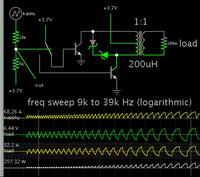David_
Advanced Member level 2
Hello.
I am designing my own driver circuit for a personal vaporizer, it's a device containing batteries, a LCD/OLED and a couple of buttons,the devices function is to supply power to a atomizer to vaporize a liquid containing nicotine.
I want to keep the device as small as possible but the max output power will be 100W, possibly 80W.
and I have to decide whether to use a DC-DC Buck-Boost solution or a Boost converter plus PWM.
The battery voltage will come from a 3,7V Li-ion battery so between 4,2v and maybe 3,2V or whatever the specific low voltage limit of the battery is at.
There will be a MCU to control everything, it will have to measure the resistance of the heating coils attached to the atomizer and be able to adjust the output power ether by adjusting a Buck-Boost converter output voltage or by controlling the output of a Boost converter for higher than battery voltages and then use PWM for lower voltages.
It isn't relevant jet(don't think it is anyway) but the device should be able to regulate the atomization process by setting a specific output wattage or by using "temperature regulation" in which mode the room temperature resistance of the heating coils is saved and then by determining the change of the resistance calculate what temperature the heating coils are at by also knowing what kind of metal there made out of. And then limit the output power to maintain a specific temperature.
To begin with I thought I would ask for advice on how to design a boost converter to boost the voltage from a 3,7V Li-Ion battery and to use it's full capacity, and I think I want more than one MOSFET in order to spread out the heat and to make the sources of heat larger in order to keep the PCB cooler.
But I have looked around for suitable control ICs but I am somewhat lost regarding what kind I should use, I have been pondering if I should use a DAC and a 3 resistor feedback divider to be able to adjust the voltage.
Does anyone know of any boost/buck-boost converter IC which uses external MOSFETs to suggest?
The output power should be able to go to 100W but with a controller with external MOSFETs the output current is dependant on the MOSFETs right.
I'm not really sure about what the problem is I am having and which makes me write here now.
Regards
I am designing my own driver circuit for a personal vaporizer, it's a device containing batteries, a LCD/OLED and a couple of buttons,the devices function is to supply power to a atomizer to vaporize a liquid containing nicotine.
I want to keep the device as small as possible but the max output power will be 100W, possibly 80W.
and I have to decide whether to use a DC-DC Buck-Boost solution or a Boost converter plus PWM.
The battery voltage will come from a 3,7V Li-ion battery so between 4,2v and maybe 3,2V or whatever the specific low voltage limit of the battery is at.
There will be a MCU to control everything, it will have to measure the resistance of the heating coils attached to the atomizer and be able to adjust the output power ether by adjusting a Buck-Boost converter output voltage or by controlling the output of a Boost converter for higher than battery voltages and then use PWM for lower voltages.
It isn't relevant jet(don't think it is anyway) but the device should be able to regulate the atomization process by setting a specific output wattage or by using "temperature regulation" in which mode the room temperature resistance of the heating coils is saved and then by determining the change of the resistance calculate what temperature the heating coils are at by also knowing what kind of metal there made out of. And then limit the output power to maintain a specific temperature.
To begin with I thought I would ask for advice on how to design a boost converter to boost the voltage from a 3,7V Li-Ion battery and to use it's full capacity, and I think I want more than one MOSFET in order to spread out the heat and to make the sources of heat larger in order to keep the PCB cooler.
But I have looked around for suitable control ICs but I am somewhat lost regarding what kind I should use, I have been pondering if I should use a DAC and a 3 resistor feedback divider to be able to adjust the voltage.
Does anyone know of any boost/buck-boost converter IC which uses external MOSFETs to suggest?
The output power should be able to go to 100W but with a controller with external MOSFETs the output current is dependant on the MOSFETs right.
I'm not really sure about what the problem is I am having and which makes me write here now.
Regards



